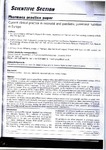Current clinical practice in neonatal and paediatric parenteral nutrition in Europe
| dc.contributor.author | Sewell, GJ | |
| dc.contributor.author | Kluttgens, BU | |
| dc.contributor.author | Nunn, AJ | |
| dc.date.accessioned | 2015-10-27T16:48:51Z | |
| dc.date.available | 2015-10-27T16:48:51Z | |
| dc.date.issued | 2003 | |
| dc.identifier.uri | http://hdl.handle.net/10026.1/3730 | |
| dc.description.abstract |
Objective: To investigate current prescribing, compounding, and administration practice of parenteral nutrition (PN) in five European countries, and to explore the use of pre-prepared batch-manufactured standard solutions. Methods: Questionnaire survey in 218 hospitals in Germany, France, Italy, Spain, and the UK. Results: 98 hospitals (45%) responded to the questionnaire. Compounding practice was found to differ greatly throughout Europe. Pharmacy aseptic compounding services were usually available in Spain (64%) and the UK (87%), but less often in Germany (35%), France (40%), and Italy (50%). Pre-prepared standard parenteral nutrition solutions were used in 25% of all hospitals surveyed for neonates, and in 17% of hospitals for children. Most of the neonatal standard solutions were prepared within the hospital, whereas commercial contractors supplied standard solutions for children. Conclusions: We found considerable differences in compounding practice in the five European countries included in the survey. Several hospitals used internally developed standard parenteral nutrition solutions. More international guidance is needed on some of the controversial issues of parenteral nutrition treatment in neonates and children, for example light protection of PN solutions during the administration process and the route of lipid emulsion administration. Also, the safety and efficacy of standard solutions requires further investigation. | |
| dc.format.extent | 122-126 | |
| dc.language.iso | en | |
| dc.title | Current clinical practice in neonatal and paediatric parenteral nutrition in Europe | |
| dc.type | journal-article | |
| dc.type | Article | |
| plymouth.volume | 9 | |
| plymouth.publication-status | Published | |
| plymouth.journal | European Journal of Hospital Pharmacy | |
| plymouth.organisational-group | /Plymouth | |
| plymouth.organisational-group | /Plymouth/Faculty of Health | |
| plymouth.organisational-group | /Plymouth/Faculty of Health/School of Health Professions | |
| plymouth.organisational-group | /Plymouth/REF 2021 Researchers by UoA | |
| plymouth.organisational-group | /Plymouth/REF 2021 Researchers by UoA/UoA03 Allied Health Professions, Dentistry, Nursing and Pharmacy | |
| plymouth.organisational-group | /Plymouth/REF 2021 Researchers by UoA/UoA03 Allied Health Professions, Dentistry, Nursing and Pharmacy/UoA03 Allied Health Professions, Dentistry, Nursing and Pharmacy MANUAL | |
| plymouth.organisational-group | /Plymouth/Research Groups | |
| plymouth.organisational-group | /Plymouth/Research Groups/Institute of Health and Community | |
| plymouth.organisational-group | /Plymouth/Users by role | |
| dcterms.dateAccepted | 2003-01-01 | |
| dc.rights.embargoperiod | Not known | |
| rioxxterms.licenseref.uri | http://www.rioxx.net/licenses/all-rights-reserved | |
| rioxxterms.type | Journal Article/Review |


